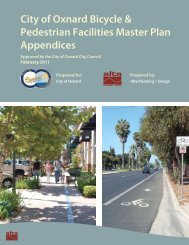View File - Development Services - City of Oxnard
View File - Development Services - City of Oxnard
View File - Development Services - City of Oxnard
Create successful ePaper yourself
Turn your PDF publications into a flip-book with our unique Google optimized e-Paper software.
WATER RESOURCES TECHNICAL REPORT2.5.2 StratigraphyThe lithologic units in the Santa Clara–Calleguas Basin can be grouped into two generalcategories: (1) upper Cretaceous and Tertiary bedrock and (2) Quaternary unconsolidateddeposits. The outcrop pattern <strong>of</strong> the lithologic units is shown in Figure 2-7 and theirstratigraphic relationships are shown in Figure 2-8. These two figures are modified from theUSGS groundwater modeling study (USGS, 2003). Figure 2-8 relates the lithologic units andformations to their associated aquifer units, which are further described below. A summary<strong>of</strong> the stratigraphic analysis by the USGS is provided below.Upper Cretaceous and Tertiary BedrockThe upper Cretaceous and Tertiary consolidated rocks include sedimentary, volcanic,igneous, and metamorphic rocks, which are virtually nonwater bearing and form the base <strong>of</strong>the Santa Clara-Calleguas Basin. Although these rocks are not an important source <strong>of</strong>groundwater, the erosion and subsequent deposition <strong>of</strong> these rocks are sources <strong>of</strong>unconsolidated deposits that form the Santa Clara-Calleguas groundwater basin. Theconsolidated Tertiary sedimentary rocks underlie most <strong>of</strong> the groundwater basin andcompose the surrounding mountains and hills. These rocks are predominantly marine inorigin and are nearly impermeable.Quaternary Unconsolidated DepositsThe Quaternary unconsolidated deposits consist <strong>of</strong> the Pico Formation, Santa BarbaraFormation, the Las Posas Sand, the San Pedro Formation, and the Saugus Formation. All are<strong>of</strong> the Pleistocene epoch and are unnamed, unconsolidated alluvial and fluvial deposits <strong>of</strong>the Pleistocene to Holocene epoch. As further described below, these unconsolidatedQuaternary deposits are grouped together into an upper aquifer system (UAS) and loweraquifer system (LAS) across the Santa Clara-Calleguas Basin.Pleistocene Epoch. During the Pleistocene epoch, major changes in sea level resulted incycles <strong>of</strong> erosion and deposition. The sequence <strong>of</strong> deposits above these erosionalunconformities typically starts with a basal conglomerate that is laterally extensive,relatively more permeable than the underlying deposits, and a potential major source <strong>of</strong>water to wells perforated in these deposits. These coarse-grained layers <strong>of</strong> fluvial and beachdeposits are interbedded with extensive fine-grained layers.The Santa Barbara Formation overlies consolidated Tertiary rocks in most <strong>of</strong> thegroundwater basin and consists <strong>of</strong> marine sandstone, siltstone, mudstone, and shale. Thethickness and lithology <strong>of</strong> the formation varies considerably throughout the basin. It isthickest, more than 5,000 feet, in the Ventura area. The formation is <strong>of</strong> low permeability andgenerally contains water <strong>of</strong> poor quality throughout most <strong>of</strong> the basin.The lower part <strong>of</strong> the San Pedro Formation consists <strong>of</strong> shallow marine sand and gravel beds.These deposits reach a maximum thickness <strong>of</strong> more than 2,000 feet in the Santa Clara RiverValley near Ventura and consist <strong>of</strong> a series <strong>of</strong> relatively uniform fine-grained sand layers100 to 300 feet thick separated by silt and clay layers 10 to 20 feet thick.The upper part <strong>of</strong> the San Pedro Formation consists <strong>of</strong> lenticular layers <strong>of</strong> sand, gravel, silt,and clay <strong>of</strong> marine and continental origin. The continental fluvial silt, sand, and graveldeposits within the upper part <strong>of</strong> the San Pedro Formation are referred to as the SaugusW112003002SCO LW1458.DOC/ 033390002 14
















